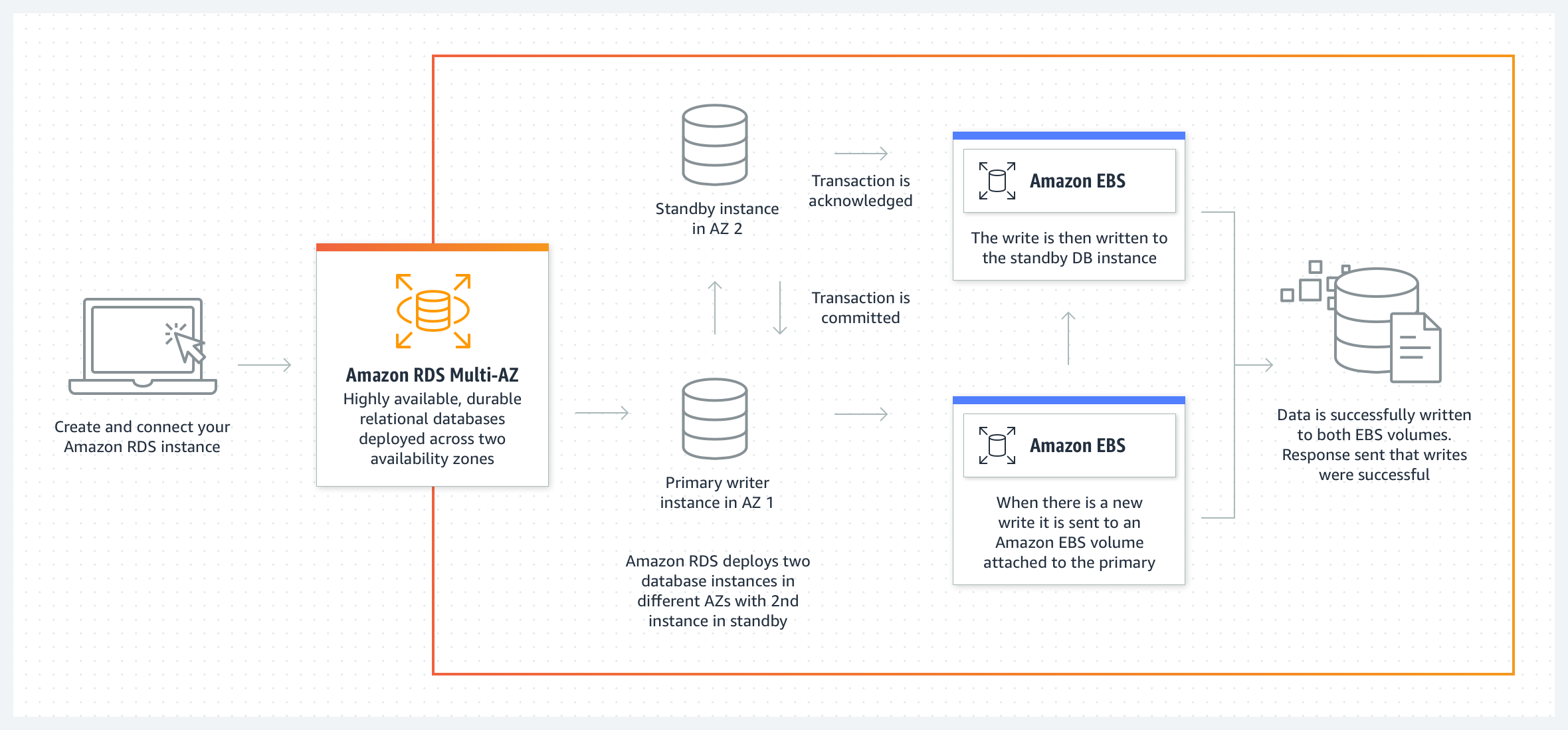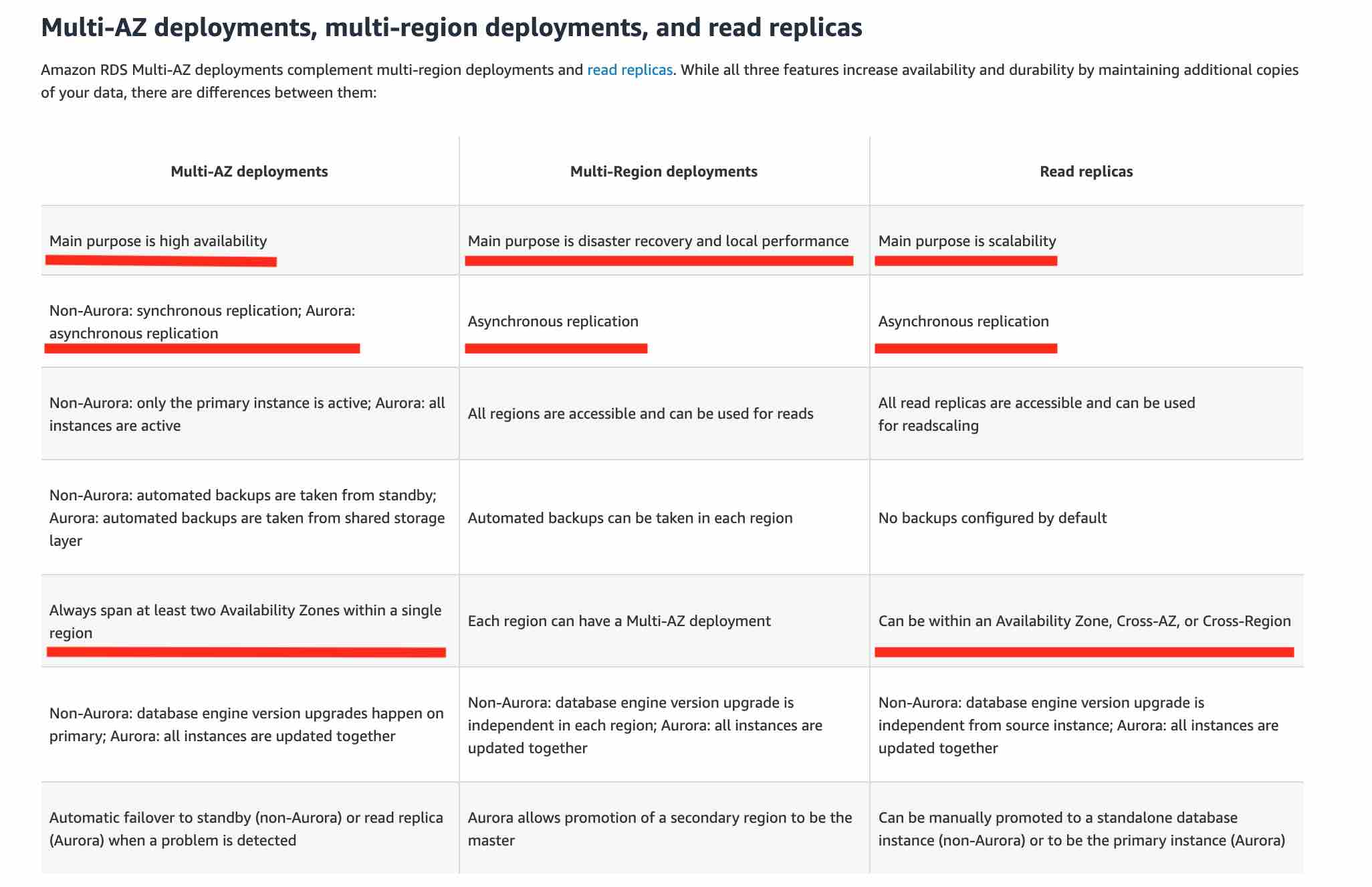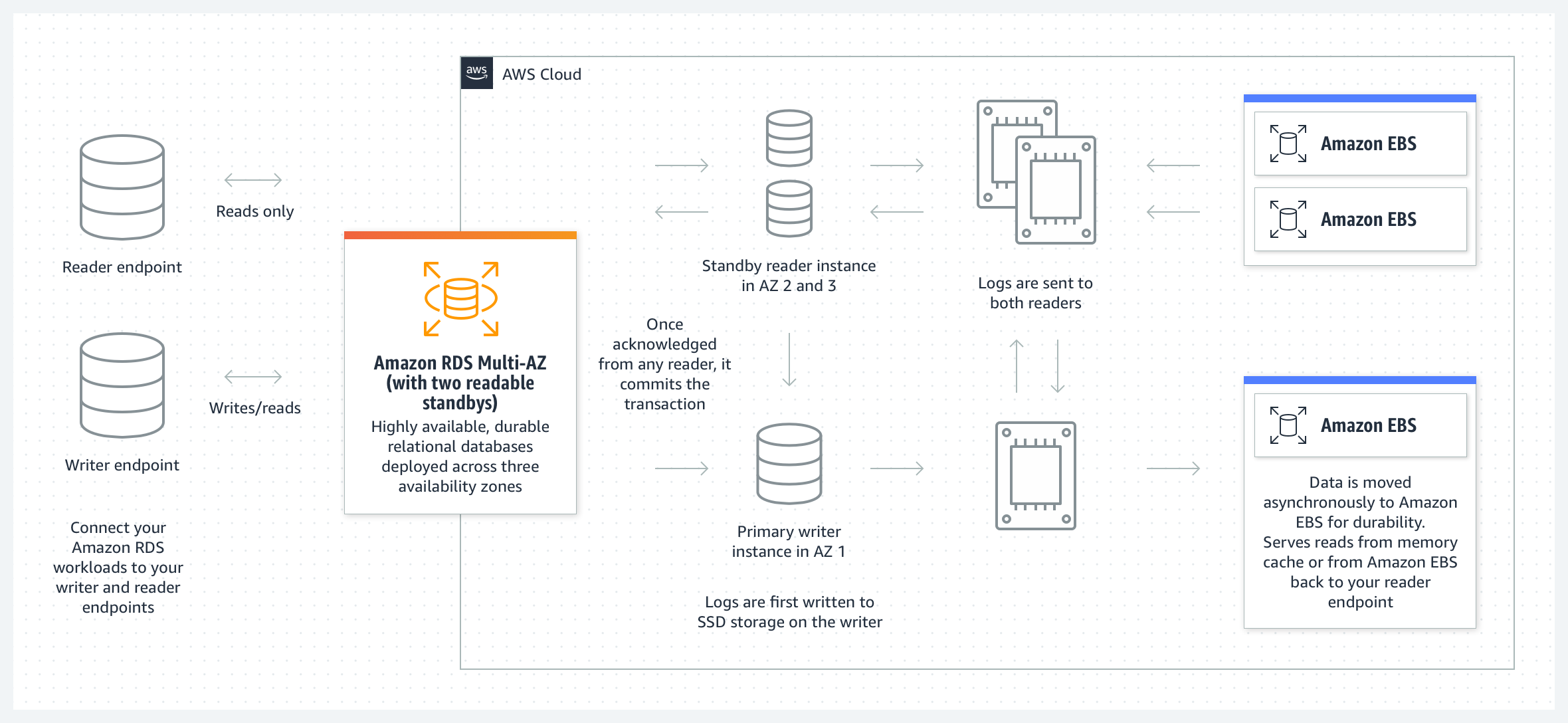Relational Database Service
https://aws.amazon.com/rds/features/multi-az/
Overview
- Managed PostgreSQL/MySQL/Oracle/SQL Server/DB2/Maria DB/Custom
- RDS resources are provisioned similar to EC2
- RDS instance size and EBS Volume type and size
- Auto-scaling
- Support for read replicas and multi-AZ
- Security through
- IAM
- Security Groups
- Key Management Service
- SSl in transit
- Backup/recovery
- Automated backup with Point in time restore
- Up to 35 days
- Manual snapshots for longer term recovery
- Automated backup with Point in time restore
- Maintenance
- Managed and Schedule (with downtime)
- Support for IAM authentication, integration with Secrets Manager
- RDS Custom for access to and customize underlying instance (Oracle & SQL server)
Configuration Types
Single-AZ Configuration
- Available engines (same as Multi-AZ with single standby)
- Amazon RDS for PostgreSQL
- Amazon RDS for MySQL
- Amazon RDS for MariaDB
- Amazon RDS for SQL Server
- Amazon RDS for Oracle
- Amazon RDS for Db2
- Additional read capacity
- none
- read capacity is limited to primary
- none
- Automatic failover duration
- Not available
- a user-initiated point-in-time restore operation is required
- This can take several hours
- point-in-time restore snapshot frequency = about 5 mins
- a user-initiated point-in-time restore operation is required
- Not available
- Minor version upgrades downtime
- When using Automatic Minor Version Upgrades, minor version upgrade downtime occurs during the Amazon RDS 30-minute maintenance window
- Higher resiliency to AZ outage
- none
- Lower jitter for transaction commits
- no optimization for jitter
Multi-AZ configuration
- Non-Aurora replicates synchronously
- Aurora type replicates asynchronously
Multi-AZ with one standby
Specifics
- Available engines (same as single-az deployment)
- Amazon RDS for PostgreSQL
- Amazon RDS for MySQL
- Amazon RDS for MariaDB
- Amazon RDS for SQL Server
- Amazon RDS for Oracle
- Amazon RDS for Db2
- Additional Read capacity
- None: Your standby DB instance is only a passive failover target for high availability
- Automatic failover duration
- as quickly as 60 seconds
- failover time is independent of write throughput
- Minor version upgrades downtime
- When using Automatic Minor Version Upgrades, minor version upgrade downtime occurs during the Amazon RDS 30-minute maintenance window
- Higher resiliency to AZ outage
- In the event of an AZ failure, your workload will automatically failover to the up-to-date standby
- Lower jitter for transaction commits
- Access to Dedicated Log Volumes
How it works
- In an Amazon RDS Multi-AZ deployment, Amazon RDS automatically creates a primary database (DB) instance and synchronously replicates the data to an instance in a different AZ. When it detects a failure, Amazon RDS automatically fails over to a standby instance without manual intervention.

Multi-AZ with two readable standbys
Specifics
- Available engines
- Amazon RDS for PostgreSQL
- Amazon RDS for MySQL
- Additional Read capacity
- Two standby DB instances act as failover targets and serve read traffic
- Read capacity is determined by the overhead of write transactions from the primary
- Lower latency
- higher throughput for transaction commits
- Up to 2x faster transaction commits compared to Amazon RDS Multi-AZ with one standby
- Automatic failover duration
- A new primary is available to serve your new workload in typically under 35 seconds
- Failover time depends on length of replica lag
- Minor version upgrades downtime
- Typically under 1 second when customers add an open source or Amazon RDS Proxy to their deployment
- Typically under 35 seconds with Multi-AZ with two readable standbys alone
- Higher resiliency to AZ outage
- In the event of a failure, one of the two remaining standbys will takeover and serve the workload (writes) from the primary
- Lower jitter for transaction commits
- Uses local storage for transactional logs to reduce jitter
How it works
Deploy highly available, durable MySQL or PostgreSQL databases in three AZs using Amazon RDS Multi-AZ with two readable standbys. Gain automatic failovers in typically under 35 seconds, up to 2x faster transaction commit latency compared to Amazon RDS Multi-AZ with one standby, additional read capacity, and a choice of AWS Graviton2– or Intel–based instances for compute.
Pricing
For Single-AZ deployments, Multi-AZ deployments with one standby instance, and Multi-AZ deployments with two readable standbys, pricing is per DB instance-hour consumed, from the time a DB instance is launched until it is stopped or deleted. Partial DB instance-hours are billed in one-second increments with a 10 minute minimum charge following a billable status change such as creating, starting, or modifying the DB instance class.
Specifics
- Available engines
- Amazon RDS for PostgreSQL
- Amazon RDS for MySQL
- Additional Read capacity
- Two standby DB instances act as failover targets and serve read traffic
- Read capacity is determined by the overhead of write transactions from the primary
- Lower latency
- higher throughput for transaction commits
- Up to 2x faster transaction commits compared to Amazon RDS Multi-AZ with one standby
- Automatic failover duration
- A new primary is available to serve your new workload in typically under 35 seconds
- Failover time depends on length of replica lag
- Minor version upgrades downtime
- Typically under 1 second when customers add an open source or Amazon RDS Proxy to their deployment
- Typically under 35 seconds with Multi-AZ with two readable standbys alone
- Higher resiliency to AZ outage
- In the event of a failure, one of the two remaining standbys will takeover and serve the workload (writes) from the primary
- Lower jitter for transaction commits
- Uses local storage for transactional logs to reduce jitter
How it works
Deploy highly available, durable MySQL or PostgreSQL databases in three AZs using Amazon RDS Multi-AZ with two readable standbys. Gain automatic failovers in typically under 35 seconds, up to 2x faster transaction commit latency compared to Amazon RDS Multi-AZ with one standby, additional read capacity, and a choice of AWS Graviton2– or Intel–based instances for compute.
Customers
SysCloud
SysCloud creates automatic backups for critical software as a service (SaaS) applications, monitors for malicious files, and delivers powerful insights about your data and compliance —all from one dashboard. SysCloud uses Amazon RDS Multi-AZ with two readable standbys for its internal monitoring system: “The new Amazon RDS Multi-AZ deployment option offers us a cost-efficient way to achieve better performance, availability, and read scalability,” said Vikram Srinivasan, Director, Infrastructure at SysCloud. “With the new Amazon RDS Multi-AZ deployment option, we expect to create a better experience for our customers.”
Multi-Region configuration
read replica configuration
- main purpose is scalability
- replicates asynchronously
- can be single AZ, Cross-AZ, or Cross Region

RDS Custom
RDS Custom for Oracle
- allows access to and customization of your underlying database server hose and OS
